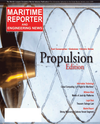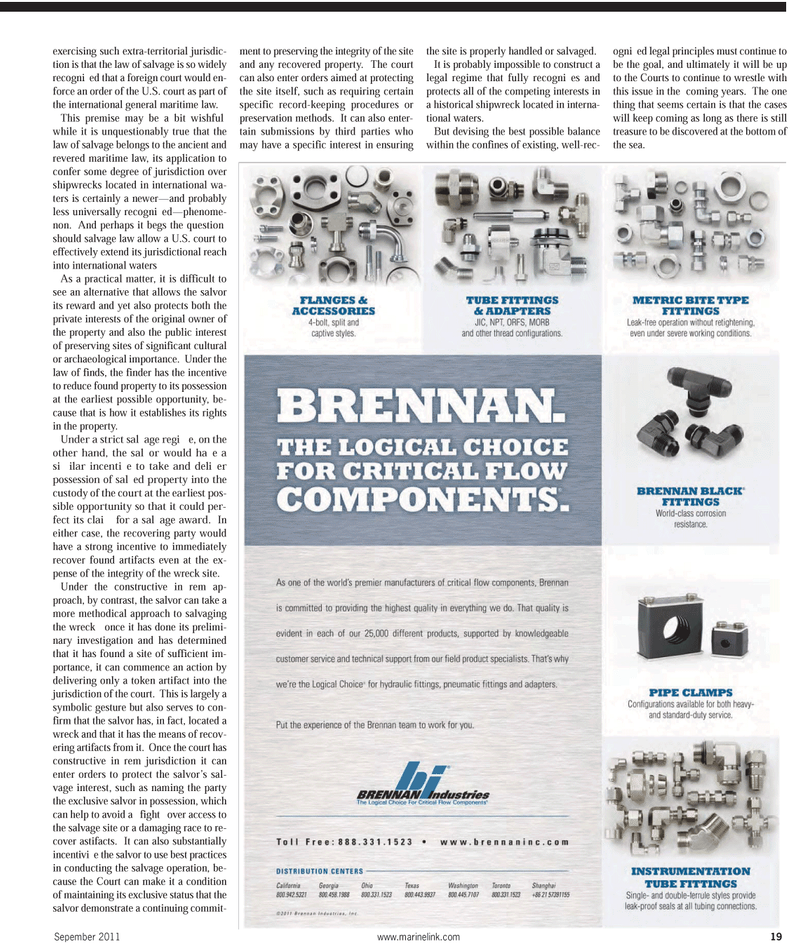
Page 19: of Maritime Reporter Magazine (September 2011)
Marine Propulsion Annual
Read this page in Pdf, Flash or Html5 edition of September 2011 Maritime Reporter Magazine
exercising such extra-territorial jurisdic- tion is that the law of salvage is so widely recognied that a foreign court would en- force an order of the U.S. court as part ofthe international general maritime law. This premise may be a bit wishfulwhile it is unquestionably true that thelaw of salvage belongs to the ancient and revered maritime law, its application to confer some degree of jurisdiction over shipwrecks located in international wa- ters is certainly a newer?and probably less universally recognied?phenome- non. And perhaps it begs the question should salvage law allow a U.S. court to effectively extend its jurisdictional reach into international waters As a practical matter, it is difficult to see an alternative that allows the salvor its reward and yet also protects both the private interests of the original owner of the property and also the public interestof preserving sites of significant cultural or archaeological importance. Under the law of finds, the finder has the incentive to reduce found property to its possessionat the earliest possible opportunity, be- cause that is how it establishes its rights in the property. Under a strict salage regie, on the other hand, the salor would hae a siilar incentie to take and delier possession of saled property into the custody of the court at the earliest pos-sible opportunity so that it could per- fect its clai for a salage award. Ineither case, the recovering party would have a strong incentive to immediately recover found artifacts even at the ex- pense of the integrity of the wreck site. Under the constructive in rem ap- proach, by contrast, the salvor can take a more methodical approach to salvaging the wreck once it has done its prelimi- nary investigation and has determined that it has found a site of sufficient im- portance, it can commence an action bydelivering only a token artifact into the jurisdiction of the court. This is largely a symbolic gesture but also serves to con- firm that the salvor has, in fact, located a wreck and that it has the means of recov- ering artifacts from it. Once the court has constructive in rem jurisdiction it can enter orders to protect the salvor?s sal- vage interest, such as naming the party the exclusive salvor in possession, which can help to avoid a fight over access to the salvage site or a damaging race to re- cover astifacts. It can also substantially incentivie the salvor to use best practices in conducting the salvage operation, be- cause the Court can make it a condition of maintaining its exclusive status that the salvor demonstrate a continuing commit- ment to preserving the integrity of the site and any recovered property. The court can also enter orders aimed at protectingthe site itself, such as requiring certainspecific record-keeping procedures or preservation methods. It can also enter- tain submissions by third parties whomay have a specific interest in ensuring the site is properly handled or salvaged. It is probably impossible to construct alegal regime that fully recognies and protects all of the competing interests ina historical shipwreck located in interna- tional waters. But devising the best possible balance within the confines of existing, well-rec- ognied legal principles must continue to be the goal, and ultimately it will be upto the Courts to continue to wrestle withthis issue in the coming years. The one thing that seems certain is that the caseswill keep coming as long as there is still treasure to be discovered at the bottom of the sea.Sepember 2011www.marinelink.com 19

 18
18

 20
20
